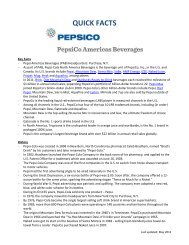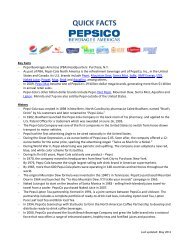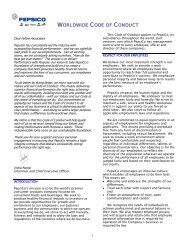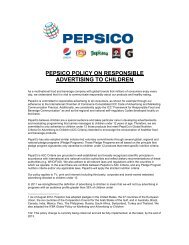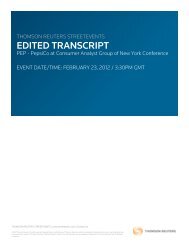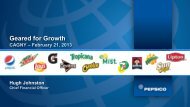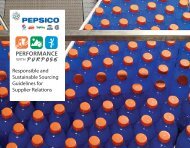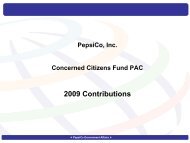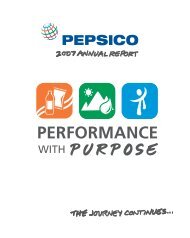Financials - PepsiCo
Financials - PepsiCo
Financials - PepsiCo
Create successful ePaper yourself
Turn your PDF publications into a flip-book with our unique Google optimized e-Paper software.
Canadian dollar and Brazilian real, partially offset by depreciation<br />
of the Venezuelan bolivar. Currency declines against<br />
the U.S. dollar which are not offset could adversely impact our<br />
future results.<br />
In addition, we continue to use the official exchange rate to<br />
translate the financial statements of our snack and beverage<br />
businesses in Venezuela. We use the official rate as we currently<br />
intend to remit dividends solely through the governmentoperated<br />
Foreign Exchange Administration Board (CADIVI).<br />
As of the beginning of our 2010 fiscal year, the results of our<br />
Venezuelan businesses were reported under hyperinflationary<br />
accounting. This determination was made based upon<br />
Venezuela’s National Consumer Price Index (NCPI) which indicated<br />
cumulative inflation in Venezuela in excess of 100% for<br />
the three-year period ended November 30, 2009. Consequently,<br />
the functional currency of our Venezuelan entities was changed<br />
from the bolivar fuerte (bolivar) to the U.S. dollar. Effective<br />
January 11, 2010, the Venezuelan government devalued the<br />
bolivar by resetting the official exchange rate from 2.15 bolivars<br />
per dollar to 4.3 bolivars per dollar; however, certain activities<br />
were permitted to access an exchange rate of 2.6 bolivars per<br />
dollar. Effective June 2010, the Central Bank of Venezuela began<br />
accepting and approving applications, under certain conditions,<br />
for non-CADIVI exchange transactions at the weighted-average<br />
implicit exchange rate obtained from the Transaction System<br />
for Foreign Currency Denominated Securities (SITME). As<br />
of December 25, 2010, this rate was 5.3 bolivars per dollar. We<br />
continue to use all available options, including CADIVI, SITME<br />
and bond auctions, to obtain U.S. dollars to meet our operational<br />
needs. In 2010, the majority of our transactions were remeasured<br />
at the 4.3 exchange rate, and as a result of the change to hyperinflationary<br />
accounting and the devaluation of the bolivar, we<br />
recorded a one-time net charge of $120 million in the first quarter<br />
of 2010. In 2010, our operations in Venezuela comprised 4% of our<br />
cash and cash equivalents balance and generated less than 1% of<br />
our net revenue. As of January 1, 2011, the Venezuelan government<br />
unified the country’s two official exchange rates (4.3 and<br />
2.6 bolivars per dollar) by eliminating the 2.6 bolivars per dollar<br />
rate, which was previously permitted for certain activities. This<br />
change did not, nor is expected to, have a material impact on our<br />
financial statements.<br />
Exchange rate gains or losses related to foreign currency<br />
transactions are recognized as transaction gains or losses in<br />
our income statement as incurred. We may enter into derivatives,<br />
primarily forward contracts with terms of no more than<br />
two years, to manage our exposure to foreign currency transaction<br />
risk. Our foreign currency derivatives had a total face<br />
value of $1.7 billion as of December 25, 2010 and $1.2 billion<br />
as of December 26, 2009. The contracts that qualify for hedge<br />
accounting resulted in net unrealized losses of $15 million as<br />
of December 25, 2010 and $20 million as of December 26, 2009.<br />
At the end of 2010, we estimate that an unfavorable 10% change<br />
in the exchange rates would have increased our net unrealized<br />
losses by $119 million. The contracts that do not qualify for hedge<br />
accounting resulted in net losses of $6 million in 2010 and a net<br />
gain of $1 million in 2009. All losses and gains were offset by<br />
changes in the underlying hedged items, resulting in no net material<br />
impact on earnings.<br />
Interest Rates<br />
We centrally manage our debt and investment portfolios considering<br />
investment opportunities and risks, tax consequences<br />
and overall financing strategies. We use various interest rate<br />
derivative instruments including, but not limited to, interest<br />
rate swaps, cross-currency interest rate swaps, Treasury locks<br />
and swap locks to manage our overall interest expense and foreign<br />
exchange risk. These instruments effectively change the<br />
interest rate and currency of specific debt issuances. Certain of<br />
our fixed rate indebtedness has been swapped to floating rates.<br />
The notional amount, interest payment and maturity date of<br />
the interest rate and cross-currency swaps match the principal,<br />
interest payment and maturity date of the related debt.<br />
Our Treasury locks and swap locks are entered into to protect<br />
against unfavorable interest rate changes relating to forecasted<br />
debt transactions.<br />
Assuming year-end 2010 variable rate debt and investment<br />
levels, a 1-percentage-point increase in interest rates would have<br />
increased net interest expense by $43 million in 2010.<br />
Risk Management Framework<br />
The achievement of our strategic and operating objectives will<br />
necessarily involve taking risks. Our risk management process<br />
is intended to ensure that risks are taken knowingly and<br />
purposefully. As such, we leverage an integrated risk management<br />
framework to identify, assess, prioritize, manage, monitor<br />
and communicate risks across the Company. This framework<br />
includes:<br />
• The <strong>PepsiCo</strong> Risk Committee (PRC), comprised of a crossfunctional,<br />
geographically diverse, senior management group<br />
which meets regularly to identify, assess, prioritize and<br />
address strategic and reputational risks;<br />
• Division Risk Committees (DRCs), comprised of crossfunctional<br />
senior management teams which meet regularly to<br />
identify, assess, prioritize and address division-specific operating<br />
risks;<br />
• <strong>PepsiCo</strong>’s Risk Management Office, which manages the overall<br />
risk management process, provides ongoing guidance, tools<br />
and analytical support to the PRC and the DRCs, identifies and<br />
assesses potential risks and facilitates ongoing communication<br />
between the parties, as well as to <strong>PepsiCo</strong>’s Audit Committee<br />
and Board of Directors;<br />
• <strong>PepsiCo</strong> Corporate Audit, which evaluates the ongoing effectiveness<br />
of our key internal controls through periodic audit<br />
and review procedures; and<br />
• <strong>PepsiCo</strong>’s Compliance Department, which leads and coordinates<br />
our compliance policies and practices.<br />
57



